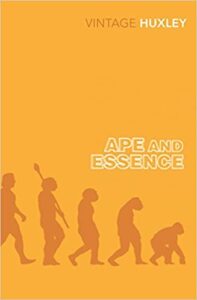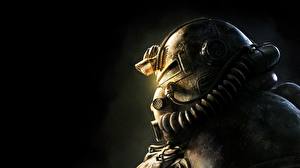The Fallout Universe is one of the most original video-game environments ever created. But it's lore, like most great science-fiction, is founded on the work of the greats who have gone before.
Like most modern gamers, I didn’t come across the Fallout series until the 2008 release of Fallout 3, an intimidatingly immense, post-apocalyptic RPG set in the ruins of a Washington DC long since destroyed by nuclear war. The first 2 installments in the series were only ever released for the PC, and so have forever existed (in my mind at least) as belonging to that kingdom of games reserved for “serious gamers”, a group who look upon gamers like me with a mixture of derision, pity and scorn.
Fallout 3 changed my perception of giant, sprawling games of this kind. The world that Bethesda softworks created, the intricacy, design and sheer scale of it, had me hooked. Having never bothered that much with RPG’s, I suddenly couldn’t get enough. I played other RPG’s, but nothing could really scratch the itch I’d been given by Fallout 3 and it’s astounding companion piece, New Vegas, released in 2009. I suspect there are thousands who feel the same way as I do.
For those completley unfamiliar with the series, a synopsis of such a detailed fictional universe is difficult, but suffice it to say that the setting is the United States in late 23rd century, 200 years after a devestating nuclear war between the US and communist China. The America of the Fallout universe never evolved beyond the cultural norms of the 1950s, and the games developers obviosly had enormous fun working the bizarre cold-war cultural references into the games fabric. Imagine a cross between Mad-Max, the novels of Ray Bradbury and 1950’s pulp fiction and you’ll be….Well you won’t even be close. These games have to be played to be understood.
The games were not without their problems. All of the Fallout games are notoriously buggy. It wasn’t out of the ordinary for your weary, war-beaten character to begin conversing with a roadside trader in search of some desperatley needed medical supplies, only for that same trader to suddenly begin levitating some 80 feet in the air, becoming completley indifferent to your consumer needs. Saved game files would corrupt. Missions that had taken the player halfway across the nuclear wasteland would suddenly be impossible to complete because the character you were supposed to meet in town had simply vanished off the face of the earth. But despite these limitations, players kept returning to the games. The story, lore and world that these games revealed was just so immersive and enjoyable that you could forgive almost any glitch or bug. Below I detail 5 of the wonderful science fiction titles that inspired various aspects of Fallout.
1. The Lone Wanderer & Dogmeat were inspired by Harlan Ellison's 1969 novella A Boy & His Dog
This dark and controversial story cycle is probably the most obvious influence on the fallout universe contained on this list. Set against the backdrop of an alternate history in which John F. Kennedy survives the 1963 assassination attempt, the Cold War takes on even more aggressive dimensions, culminating in global nuclear war.
Fast forward to 2024, where 15 year-old Vic and his dog Blood scour the wasteland of the Southwestern United States in search of food, sex and shelter. Vic is completley amoral, having grown up a ravenous child of the wastes, his only concerns relate to his own immediate satisfaction. Blood on the other hand, is intelligent, erudite and telepathic. He helps Vic to locate women in exchange for scraps of food, neither one of them particularly troubled by what seems right or wrong.


Their travels eventually bring them across Quilla June Holmes, a teenager from “Downunder”, a society based in a large, underground vault (sound familiar?). The society of Downunder is a weird pastiche of 1950’s America, where the listless inhabitants remain blissfully unaware of the nasty state of things on the surface, a land inhabited by raiding gangs, giant mutated insects and the terrifying “Burnpit Screamers”, an inspiration for Fallout’s Super Mutants.
Anyone reading Ellison’s stories will become instantly aware of the similarities with the Fallout canon. A lot of the original ideas are here. What is decidedly not here however, is Fallout’s trademark wacky, humourous style. These stories are bleak and unrelenting, culminating in a sordid medley of cannibalism and savagery, with no lessons learned. For fans of post-apocalyptic sci-fi, these stories offer an original glimpse of a fictional world that spawned many imitators, but Fallout fans may find that the distinctive sense of fun is sorely lacking.
2. The Brotherhood of Steel was inspired by Walter Miller's 1959 novel A Canticle For Leibowitz


Once again, there is nuclear devestation, once again our setting is the Southwestern United States, or at least what’s left of it. The difference between this and Ellison’s work though, is that A Canticle for Leibowitz is genuinely brilliant. Following the “flame deluge” that engulfed the world in nuclear fire, a backlash against technology and learning of any kind permeates society, with a group proudly calling themselves the “Simpletons” taking it upon themselves to subvert technological progress and burn books.
Enter Isaac Edward Leibowitz, a quiet and scholarly Jewish electrical engineer, enlisted with the US army. Following the death of his wife in the war, Isaac sets himself against the forces that are hell-bent on “simplification”. He takes holy orders and begins hoarding books, essentially trying to save the learning of mankind from the hoards hellbent on destroying it. He is promptly betrayed, martyred and beatified by the Catholic Church. His order endures though, and evolves into an organisation which collects and hoards the technological acheivements of bygone days, until barbaric humainty is once again “ready” to wield it.
This is full-on, lore-based science fiction, with a narrative spanning thousnads of years. There are moments when the narrative can run away with itself a little, but overall, fans of the Fallout universe who appreciate a meticulously woven sci-fi world will thouroughly enjoy this novel. Most importantly, Miller’s book poses engaging and interesting questions about humanity’s capacity to balance technological and cultural advancement.
3. Vault 101 was inspired by Philip K. Dick's The Penultimate Truth
At the outset of Fallout 3, the main character lives a boring, proscribed but ultimately safe life in the confines of Vault 101, beneath the ruins of Washington DC’s devestated hinterland. Shielded from the harsh realities of life by their father (voiced by Liam Neeson), the player-charcater remains blissfully unaware of the resentment buiding towards the vault’s all-powerful “overseer”, and goes along with the accepted “truth”, that the residents of Vault 101 are the only remnants of the human race. The residents believe that nuclear fire still rages on the surface, and that any attempt to escape would result in insatnt immolation on the surface world.

As all who have played the game will know, unravelling this deception and escaping to the ruins of Washington D.C. merely serves as the first chapter in this epic storyline. This opening subplot is one of the most ingenious in the Fallout universe, but it has it’s origins in Philip K. Dick’s The Penultimate Truth, published in 1964. Dick’s bleak post-apocolaptic work details a full-scale nuclear war, fought at some point in the early 21st century. With the world devestated, humankind retreat to vast “ant-tanks” or underground vaults. The surface-world continues to function under the guidance of the “yance-men”, who urge the underground dwellers to continue the production of goods for the war effort. The Yance Men’s motives for keeping the population in ignorance about the ongoing nature of the war become clear as the novel progresses, and without giving too much away, any Fallout fan will immediatley recognise similarities between the Yance-Men and the “Enclave” the remnants of the original US government in the Fallout universe. The influence of The Penultimate Truth on Fallout is obvious, and it is genuinely a compelling science fiction novel, even if it does suffer from Dick’s usual penchant for trying to fit far too many ideas and subplots into one 300 page novel.
4. The "Wasteland Wanderer" concept was largely influenced by David Brin's The Postman
Most people will only remember The Postman from the god-awful film-adaptation starring Kevin Costner, a movie which recieved an astonishing 8% fresh approval rating on Rotton Tomatoes. The novel though, is actually pretty good, and you don’t have to delve very far into this chunky tome before seeing the influence this story has wraught on the Fallout universe. Brin has a tendency to pen huge, sprawling science fiction novels that even die-hard fans have to admit could do with a bit of editing-down. However, The Postman is one of those rare gems, a 400+ page science fiction novel that holds your attention firmly until its climax.

On the face of it, the premise of The Postman is relatively simple. Gordon Krantz, an aimless wanderer in the post-apocalyptic wasteland, loses his worldly possessions to a gang of raiders. He shelters in a discarded, ancient US mail truck, where he discovers a Postal uniform and a large quantity of undelivered pre-war mail. Traipsing around southern Oregon with his mail bag, Krantz happens across a settlement. There, his claims to be a representative of the “Restored United States” sparks a wave of hope, with the inhabitants desperate to believe in some tenuous link to the pre-war world.
Here, the novel takes on a more philosophical tone. There’s a lot of talk of society only developing through institutions that have gone before, much like in Fallout. Just as people invest their faith in institutions like the “Restored United States”, so in Fallout all of the main factions are remnants of powers that had reigned in thh prewar world; The New California Republic, The Minutemen, The Enclave, even Caeser’s Legion. The main reason to read The Postman though is that it’s just bloody good fun. There’s politics sure, but also action, violence, raider groups (in the form of “hypersurvivalist militia”) and even a little romance.
5. The savage tribal structure of society in Fallout was largely infuenced by Aldous Huxley's Ape & Essence

Everyone will be familiar with Huxley’s dystopian masterpeice Brave New World, but Ape & Essence is a significantly darker and more engaging work. The portrayal of tribal society in the novel will remind who has spent time in the Capital Wasteland, The Mojave or the Commonwealth. Cannibalism, raider gangs and irradiated, ghoul-like troglodytes abound.
Set in the year 2108, the New Zealand Rediscovery Expedition reaches the coast of California after months at sea. It is over a century since nuclear war devestated most of the planet, and the survivors struggle to adapt to the radioactivity and disease that still lingers. The crew are braced for the physical destruction they come across in California, but they are totally unprepared for the scale of savagery and moral degredation they encounter.
Like most great fictional universes, the Fallout series mixes an astounding dash of originality with a whole lot of inspiration from what has gone before. In recent years a tonne of novels have been written which obviously draw deeply from the Fallout well. Some of these have been dreadful, but anyone who enjoys good science-fiction of any sort should read Hugh Howey’s Silo series, the first of which, Wool, was published to wide acclaim in 2014. If you think we’ve left anything our, or you have recommendations of books inspired by the world of Fallout, let us know below! You can purchase any of the books featured in this article by requesting them on our bookshop pagebookshop page.


